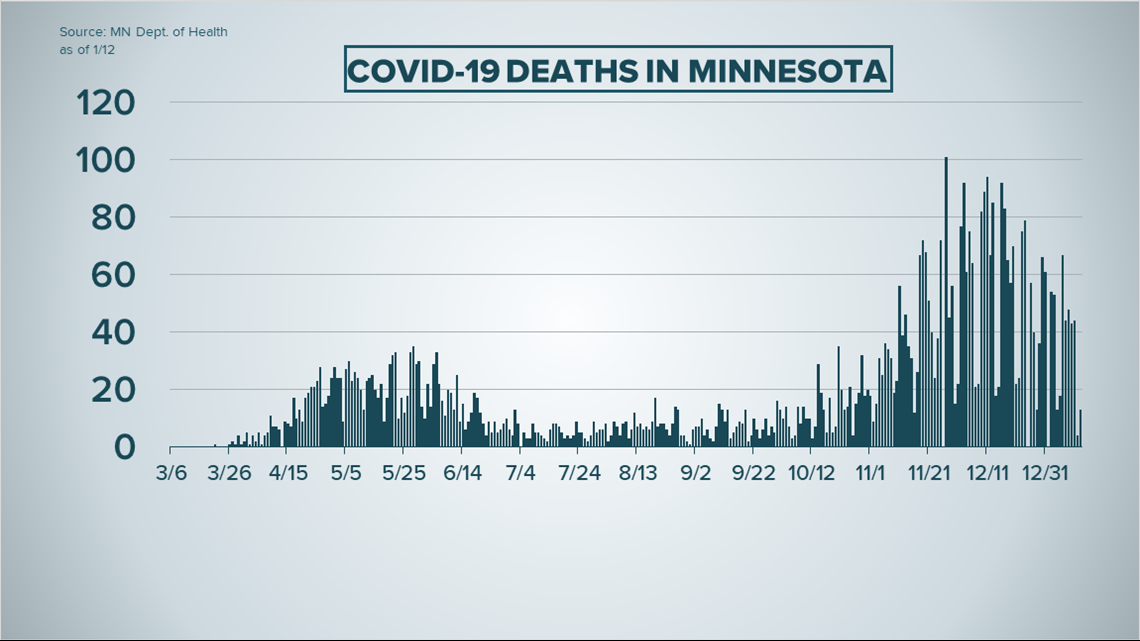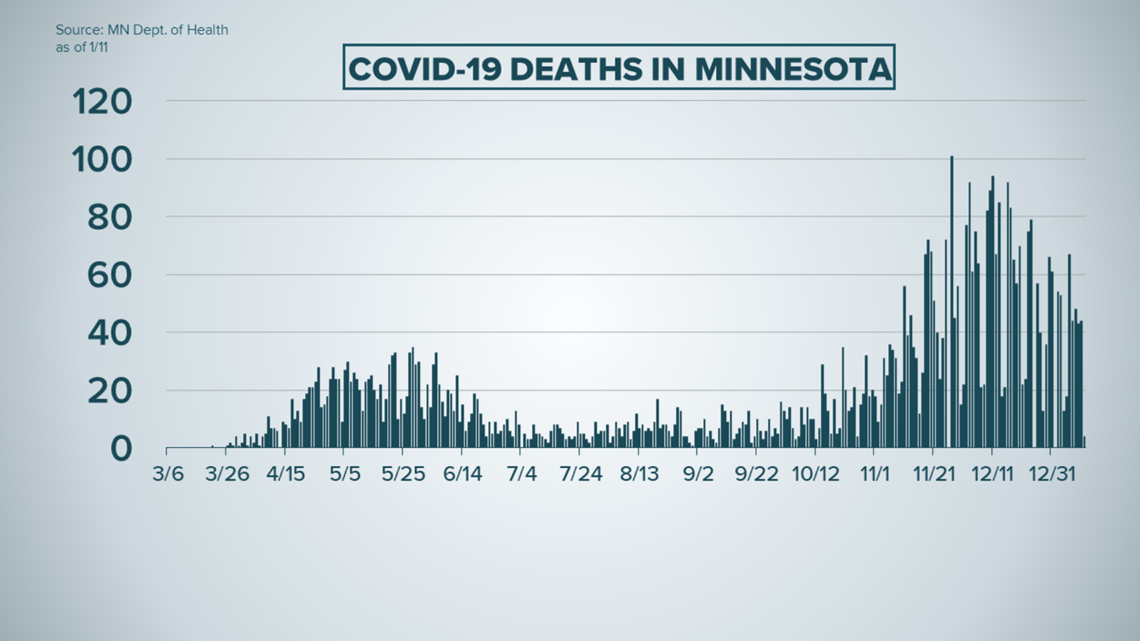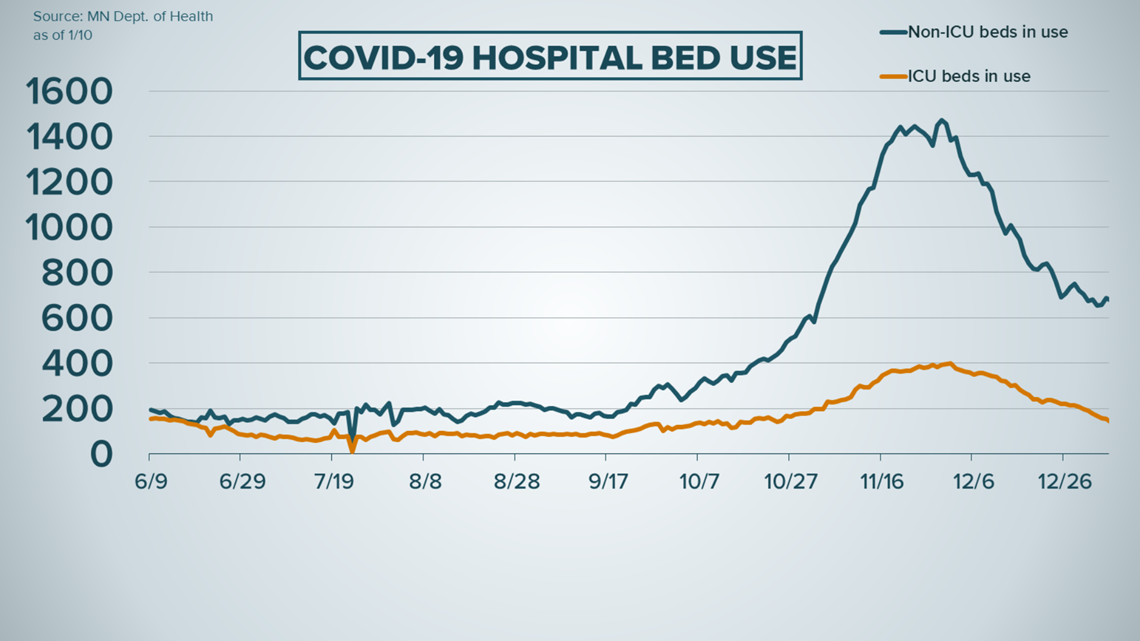ST PAUL, Minn. — Tuesday, Jan. 12
- MDH unveils new COVID-19 vaccine dashboard
- Technical glitch pushes new case numbers artificially higher
- Bars and restaurants open indoor dining at 50% capacity
- Five cases of new COVID-19 strain confirmed in MN
2 p.m.
The Minnesota Department of Health held their daily coronavirus briefing Tuesday, in which they outlined the rollout of the state's new COVID-19 vaccine dashboard. (mn.gov/vaccine)
The new online tool is intended to help the public track Minnesota's vaccine distribution progress, including how many doses are available in the state, as well as who's being vaccinated right now.
"We wanted to share this information in a meaningful way, a way that helps shape opportunities for improved vaccine delivery, and provides clear insight into the decision making process," said Commissioner of Minnesota IT Services Tarek Tomes.
Tomes says the new daily dashboard will help outline the state's vaccine distribution progress, both in terms of localized information, as well as federal-level commitments to the state of Minnesota - and whether those commitments are being achieved or not.
"The goal of this new dashboard is to provide a more visual and user-friendly way to view key vaccination data for our state," says MDH Infectious Disease Director Kris Ehresmann.
However, in MDH's journey to make the data as easy to understand as possible, Ehresmann says the task is complicated by the "different types of vaccine allocations there are and what [they're] able to track."
In particular, she noted, it is difficult for MDH to track and monitor certain groups - like veterans affairs recipients or recipients of the Indian Health Service.
Despite these challenges, Ehresmann stated the dashboard would be updated daily starting at 11 a.m., unless noted otherwise - though some information will be updated weekly.
Ehresmann went on to outline the state's current vaccine distribution outlook.
Currently, she says the state is still in phase 1A of distribution, which includes those within assisted living facilities, as well as healthcare workers.
Ehresmann says MDH expects to finish phase 1A by the end of January, and commented on the Trump administration's Tuesday morning announcement to revise its guidance on vaccine distribution to states.
"More vaccine becoming available to more people more quickly would be a welcome development, but we will follow the adage 'trust, but verify,'" Ehresmann said. "A promise to deliver isn't delivering, and we've learned to be patient with federal government promises."
At the time of Tuesday's MDH call, Ehresmann said that Minnesota had not yet received any additional vaccine doses, and the state health department has yet to receive the new federal guidance in writing.
In the meantime, the state says it continues to target those most at risk of contracting COVID-19 - though Ehresmann says the state has preparations in place to scale efforts should more vaccines become available.
"We are ready to receive more vaccines if the feds actually follow through on their promise," she said.
MDH expects the next group of eligible people to include individuals "whose age puts them at increased risk" and individuals who have underlying health conditions.
11 a.m.
Data released by the Minnesota Department of Health (MDH) Tuesday indicates 1,335 new cases of COVID-19 recorded in the past day, but a technical glitch reported Monday means the actual number is less than that.
On Monday, department spokesman Doug Schultz told KARE 11 that a file that loaded late pushed 558 positive tests to Tuesday's total. That means the actual number of new single-day cases on Tuesday is closer to 777 or so. Those cases, and the ones included from Monday are based on results from 29,315 tests (28,339 PCR, 976 antigen) processed in private and state labs.
Health officials consider a positive PCR test a confirmed COVID case, while a positive antigen test is considered a probable case.
Minnesota has now recorded a total of 438,867 coronavirus cases since the start of the pandemic, with 16,921 of those attributed to antigen tests.
Thirteen more Minnesotans have died of COVID-19, bringing total fatalities to 5,724. Of those deaths 3,660, or 64% of them, are linked to long-term care or assisted living settings.


Currently 144,503 Minnesotans have received one dose of vaccine, while 7,392 have completed the two-dose series. Minnesota health care providers have received 329,450 doses so far, while the CDC has sent 100,500 doses as part of the federal long-term care vaccination program. More information can be found on MDH's new COVID-19 vaccination dashboard webpage.
Hospitalizations across the state due to COVID-19 continue to trend downward. As of Monday 692 Minnesota hospital beds were being used for coronavirus patients, with 135 of those beds in the ICU. In the Twin Cities metro bed availability is improving, with 5.1% of non-ICU beds being open (188). Availability of ICU beds is slightly down at 7.7% (53 beds available).
Total hospitalizations since the onset of COVID-19 are now at 22,931, with 4,811 of those patients requiring treatment in the ICU.


MDH says 418,610 patients who once tested positive for the virus have recovered to the point they no longer need to be isolated.
The largest grouping of deaths due to COVID-19 involve Minnesotans ages 85 through 89, with 1,077 fatalities in 5,786 diagnosed cases. Young adults make up the largest number of coronavirus cases, with those 20 to 24 recording 44,338 cases and three deaths, and 25 to 29-year-olds making up 39,578 cases and six deaths.
Hennepin County has the most COVID activity in the state with 91,292 cases and 1,448 deaths, followed by Ramsey County with 39,186 cases and 723 deaths, Dakota County with 32,330 cases and 310 deaths, and Anoka County with 30,475 cases and 352 fatalities.
Cook County in northeastern Minnesota continues to report the least COVID activity in the state, with 111 cases and zero deaths.
Monday, Jan. 11
2 p.m.
Minnesota health officials held a media briefing call to update the public on COVID-19 across the state, and the new variant originally identified in the UK.
Five cases of the variant, called B.1.1.7, were reported in Minnesota over the weekend.
Minnesota Department of Health (MDH) Commissioner Jan Malcolm said Monday's low number of four deaths reported is welcome, but does not necessarily indicate the numbers will continue to go down.
"That often is an artifact of weekend reporting from the mortuaries," Malcolm said. Unfortunately other lower days recently have not turned into a "trend," she said.
Malcolm said MDH is continuing to watch an uptick in test positivity and new COVID-19 cases.
MDH Public Health Lab Assistant Director Sara Vetter joined the call to talk about the new strain of COVID-19 now identified in Minnesota.
Five people from four different counties tested positive for the new variant, Vetter said. Four were identified through the MDH public lab, and one through a CDC collaboration. The counties were Hennepin, Dakota, Carver and Ramsey, MDH said, and two lived in the same household.
MDH Infectious Disease Director Kris Ehresmann warned that even though the new variant has only been identified in those counties so far, health officials are confident that it's spreading more widely than that.
"This is circulating in Minnesota," Ehresmann said.
The cases range from ages 15-37 and their illness onsets were all between Dec. 16 and Dec. 31. None were hospitalized. Two people reported international travel, one did not travel, and two had unknown travel history. MDH is continuing to investigate their exposure and their close contacts.
Vetter said officials don't yet know why the new variant may be impacting young people more.
"In general we see this virus affecting that age group more and so this variant kind of follows that pattern," she said.
"We expected that at some point we would find the virus in Minnesota," she added. "Knowing that it is now here does not change our public health recommendations."
Vetter said that while the new variant spreads more quickly, it does not appear to be more dangerous. Health officials also believe that the current COVID-19 vaccines will be effective against the new strain.
When asked whether vaccines will be needed annually, Ehresmann pointed out that experts do not yet know how long immunity lasts once someone has had COVID-19.
"It may be that it's necessary to receive an annual vaccination because of the duration of the protection," she said. But Ehresmann acknowledged that new variants could also prompt a need for regular vaccines, similarly to the flu shot.
"We are continually screening for new variants," Commissioner Malcolm said. "So we have been doing so all along and we will continue to do so."
Malcolm said that MDH expects that the new, faster-spreading variant, combined with the increased indoor time this winter, will cause an increase in COVID-19 cases in Minnesota.
According to the CDC, 63 cases of the new variant have been identified in eight states, Vetter said.
Regarding Minnesota's progress getting vaccines administered, Malcolm acknowledged that not every aspect is under MDH control.
"Are we satisfied?" she said. "No. We would like to speed up every step of that process that we can."
Malcolm said health officials "hope and intend" to improve in state-to-state comparisons of vaccine progress, even though she contended those comparisons are not always "apples to apples."
11 a.m.
The latest COVID-19 data reported Monday by the Minnesota Department of Health (MDH) shows the lowest case numbers, deaths and testing volumes in recent memory, partially due to a technical glitch.
MDH says 980 cases of coronavirus were recorded in the past day, based on results from 15,980 cases (14,993 PCR, 987 antigen) processed in private and state labs. Health officials consider a positive PCR test a confirmed COVID case, while a positive antigen test is considered a probable case.
The state has reported a total of 437,552 positive tests (16,836 from antigen tests) since the pandemic began.
Four more Minnesotans have died from COVID-19, bringing total fatalities to 5,711. It is the first single-digit death total since Nov. 2, when 9 people perished from the virus.


MDH spokesman Doug Schultz explains that a delay in loading a file with tests from Sunday resulted in those results not making it into Monday's report, creating numbers that are artificially low. Schultz says there were 558 positive test results from the file that will be included in Tuesday's report, making tomorrow's case numbers artificially high.


Schultz adds that it's important to know that "the 558 positive tests in that file represent both new COVID cases and repeat tests on known cases, so the number of new cases represented by that file (to be reported Tuesday) will ultimately be less than 558."
Vaccinations given to vulnerable groups, front line workers and first responders now sit at 147,645.
The number of patients hospitalized statewide with COVID-19 continues on a steady decline. As of Sunday 686 beds were being used to treat coronavirus patients, with 141 of them in the ICU. Availability of beds in Twin Cities metro hospitals is steady, with 3.9% of non-ICU beds open (142), and ICU beds have an availability rate of 9.4% (65).


Total hospitalizations for COVID-19 now sit at 22,815, with 4,783 of those patients needing ICU care.
MDH says 417,005 people who at one time tested positive for the virus have recovered to the point they no longer require isolation.
Young adults continue to make up the largest grouping of COVID cases: Those 20 to 24 account for 44,195 cases and three deaths, while 25 to 29-year-olds number 39,474 cases and six deaths. People 85 to 89 comprise the largest group of fatalities from the virus with 1,075 in 5,774 diagnosed cases.
Hennepin County has recorded the most COVID activity in the state with 91,060 cases and 1,447 deaths, followed by Ramsey County with 39,054 cases and 722 deaths, Dakota County with 32,250 cases and 309 deaths, and Anoka County with 30,430 cases and 347 fatalities.
Cook County has the least COVID activity with 111 cases and zero deaths.
KARE 11’s coverage of the coronavirus is rooted in Facts, not Fear. Visit kare11.com/coronavirus for comprehensive coverage. Have a question? Text it to us at 763-797-7215. And get the latest coronavirus updates sent right to your inbox every morning. Subscribe to the KARE 11 Sunrise newsletter here. Help local families in need: www.kare11.com/give11.
The state of Minnesota has set up a data portal online at mn.gov/covid19.

